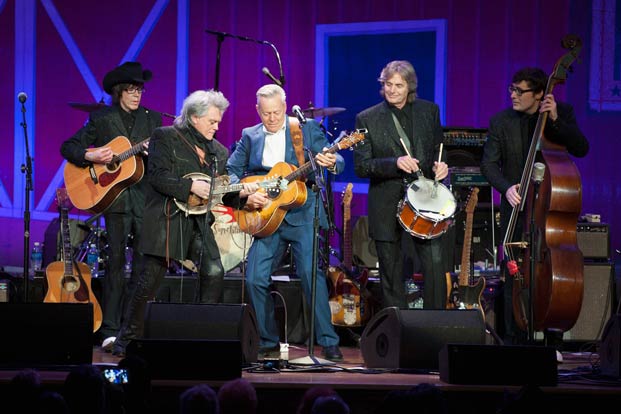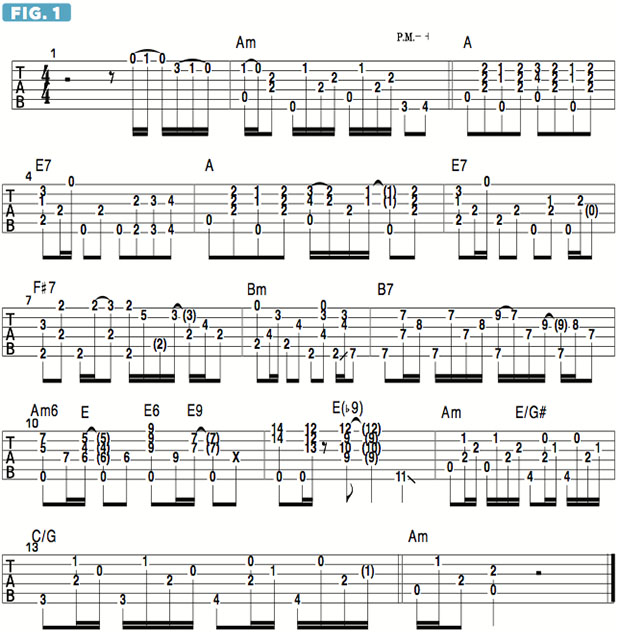Tommy Emmanuel's Guide to Hand Independence, and More on Chet Atkins' “El Vaquero”

Last month, I kicked off this series of columns with a look at the Chet Atkins/Wayne Moss masterpiece, “El Vaquero,” which I covered on my latest release, It’s Never Too Late.
Chet and Wayne cut it as a two-guitar piece, but I’ve arranged it for one guitar, and it can be a bit of a tricky challenge to cover both the melody line and rhythm accompaniment simultaneously.
Throughout the piece, I utilize standard Merle Travis–style fingerpicking technique: the bass notes, sounded on the bottom three strings, are picked with the thumb (I use a thumb pick), usually in an “alternating-bass” fashion, and the notes on the top three strings are picked with either the index finger, middle finger or both together.
The general fingerpicking approach, which I apply throughout 95 percent of the tune, is that the thumb-picked bass notes fall in a steady eighth-note rhythm (“1 and 2 and 3 and 4 and”), while the melody line and chordal accents, sounded with the index and middle fingers, fall on the eighth- and 16th-note upbeats between the downbeats. You’ll find that many of the bars include 16th notes, and in these instances the index- and middle-finger movement falls in the spaces between the eighth notes.
Last month, we took a look at the verse section of “El Vaquero,” so this month I’d like to explore the bridge. FIGURE 1 starts off with the last two bars of the verse, to serve as a point of reference; the bridge itself begins at bar 3. Right here, the song modulates from the key of A minor to A major, and I begin the section by playing alternating bars of A and E7.
I embellish the A chord by simply sliding down one fret to G# and then back to A; in the subsequent bar, I play a chromatically ascending series of 10th intervals, or 10ths, sounded on the G and low E strings. The harmony of a 10th is the same as that of a third, except the higher note is moved up one octave. I use 10ths here to reference E/G#, which serves as a good way to move back into the A chord.
In bar 5 of the bridge (bar 7 of FIGURE 1), a relatively complex melody is played over the F#7 chord: keep your fret-hand index finger barred across all of the strings throughout this bar, as doing so will facilitate moving between the melodic line and the moving bass, all the while allowing the notes to sustain into one another.
This is followed by a straight Bm barre chord at the second fret, with the open high E string allowed to ring on top of the chord. Bm is followed by a transition to B7 (the “two major” chord, which may also be thought of as the “five of five”), and once again the index finger barres across all six strings to facilitate the added melodic line.
Notice the cool and somewhat unusual E(b9) voicing in bar 11, fretted with a barre across the top four strings at the ninth fret. In the last two bars of the section, I play a chromatically descending bass line that moves from A to G# to G and then back up, referencing the chord progression Am E/G# C/G. As you can see, there are many complex areas of this tune, in terms of the melody and required picking pattern, so study the piece one bar at a time and slowly build up the tempo.

Get The Pick Newsletter
All the latest guitar news, interviews, lessons, reviews, deals and more, direct to your inbox!
Tommy Emmanuel is an Australian guitarist, who's worked as a session player and won awards for his solo recordings. He is one of the finest acoustic players working today. In 2019, MusicRadar named him as one of the 10 best acoustic guitarists in the world.










